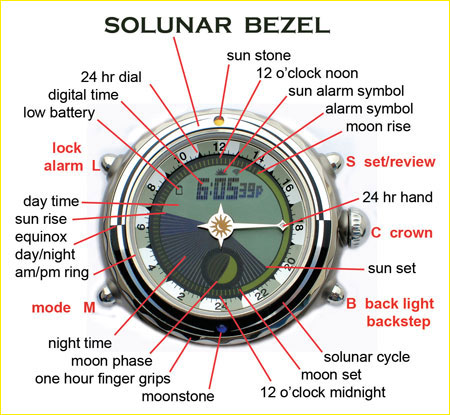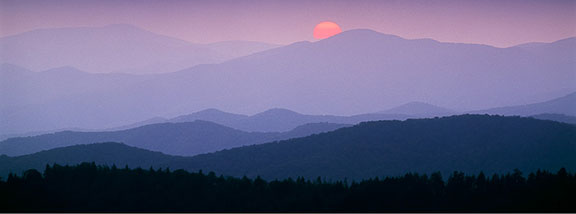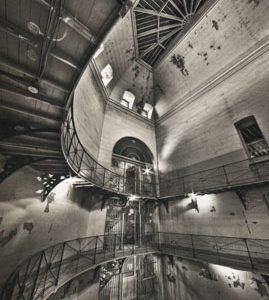
It’s a cliche that sometimes still needs repeating. Photography is as much about light as it is about subject. For the landscape and nature photographer light means the sun. The quality of light is determined, of course, by the time of day as well as atmospheric conditions. We also know that directional light is dramatic, and the warmth of early morning and late afternoon light can make an otherwiseso-soforeground come to life.
Just wandering out to do some shooting at any old time of the day is not likely to lead to anything terribly exciting. And when planning a location shoot, whether in the next county or the other side of the world, knowing when sunrise and sunset will take place, and planning your travels and positioning accordingly can make the difference between "Nice" and "Oh Wow!".
When I plan a landscape shoot and I have any flexibility at all in my scheduling, I always try and have it coincide with a full moon. Each month, for a few days before and a few days afterward, the moon can become an important element in the landscape, and knowing when it will rise and set is for me as integral a part of planning a shoot as remembering to bring a polarizer or extra memory cards.
____________________________________________________________________________________
Planning Ahead
Knowing when sunrise and sunset, moonrise and moonset will take place, and also the phase of the moon, is not difficult to determine. There are any number of web sites that provide this data, and programs for laptops and PDA’s are readily available that provide the same information.
But what about next week in Alaska, or next September in Botswana? And when will the moon be risingthis evening–before or after we get back to our campsite?!
While the Internet, laptops, and PDA’s can all provide this information, having the full range of this data always available when traveling or when thinking about a shoot, whether it happens later that same day or next year in Australia, can now also be determined by your watch. Not just any watch, but the uniqueYES Watch.
____________________________________________________________________________________
The Smaller YES Watch
Regular readers will know that I am a bit of a watch aficionado. I wrote a piece in August, ’07 about how to makea camera buying decisionby using a watch purchase as an analogy.
Being interested in watches, I first came across theYES watchin 2000, not long after it first came out. I bought one, but found that though it did everything I wanted it to, it was far too bulky for regular use, and so I ended up abandoning it for alternative sources of information. But I frequently would glance at it in the cupboard, thinking how nice it would be to have something like it, except smaller, and therefore more amenable to regular use.
In 2007 I discovered that at some point in recent years the YES watch line had been revamped, and in particular that a new model, theCozmohad become available. Rather than the he-man 48mm size of the previous generation, the Cozmo is 43mm, still a bit largish, but about the size of many popular sports watches. The trade-off is that it is made of steel instead or titanium, and is therefore a few ounces heavier, something which I don’t find to be at all problematic. Also, at just under $500 for the least expensive stainless steel model it is several hundred dollars less expensive than the larger but lighter titanium models.
____________________________________________________________________________________
What it Does
There are several different models of the YES watch, in different sizes, with different bezels, and with different wrist bands. But they all essentially do the same things in the same way. The differences are mostly cosmetic, and in size, weight, and cost.

Functionally complex, and somewhat confusing until you take away the legends and lines from the above schematic, what you have is an economy of presentation. What one can see at a glance are the time in digital display format, and an hour hand showing the current hour on a 24 hour basis, with noon at the top and midnight at the bottom of the dial. The light-toned part of the LCD dial shows the hours of daylight against the 24 hour dial, while the dark area shows nighttime, both of which change, of course, over the course of the year. The current phase of the moon is shown by the moon phase icon, while the LCD’s rim shows the time of moonrise and moonset against the 24 hour dial.
For me the real beauty of the YES Cozmo lies in its analogue representation of a large number of important pieces of information. When digital display watches first appeared they were in large part rejected because it takes a different part of the brain to translate digits into time than it does the position of hands. On the YES watch, with the exception of the actual digital display at the 12 o’clock position, all other information is graphical and analogue in nature. This means that it’s as easy to read and comprehend as the hands on a clock. Youknowwhat time it is, without having to mentally interpret numbers. And in the case of the YES watch thatknowingnow includes a range of information of value and interest to landscape photographers – including the ratio of daylight to night, sunrise and sunset times, the phase of the moon, and the times of moonrise and moonset for that day. Quite an accomplishment.
Programmed into the YES watch are data for nearly 600 cities around the world, and one also has the ability to enter an exact location via longitude and latitude. The watch is able to calculate all of its functions for any location on earth, and for any date until the year 2099. In addition it can show a second time zone along with all astronomical data at the push of a button, has an illuminated backlight, an alarm, countdown timer, and so on and so forth. Oh yes, and it can also be set to sound an alarm 30 minutes before sunrise or sunset.
Not that it’s that relevant to photography, but the YES watch also can be used as a solar compass (on a clear day) and also to indicate the time of high tide and low tide, all through its LCD display and rotating bezel. Very clever, and very useful.
The point of all this legerdemain is that the YES watch provides anyone needing to know the basic astronomical information associated with outdoor photography or film production with not only the key information needed today, but also what is needed for planning shoots well into the future and anywhere on the globe. There’s nothing else on the market like it that I know of, and for as low as $495 it’s not outrageously priced.
____________________________________________________________________________________
Choosing a Model
If theYES Watchcatches your fancy you may find that the company’s web site can be a bit confusing. Here are the things to consider. There are five models, all of which have essentially the same functionality. TheTatiis a smaller watch lacking the mechanical hour hand, and I don’t particularly care for the cosmetics, though it is the smallest.
The largest models are the 48mmZulu,IncaandKundalini. These are made of titanium. TheCozmois the mid-sized model with a 43mm case, but it is made of stainless steel rather than titanium. It is also priced between $495 and $595, while the larger titanium watches range from $795 to $995. The more expensive models also come in a fancy presentation case, which may be a factor if you want to give one of these as a gift to a photographer friend. (Hint to wives!)
Each of these watches can be had with one of three different bezels –Solunar,24 HourandSymbol. Each adds some minor functionality of a different type, and each has a different cosmetic appeal. They are well illustrated on the web site. I chose the Solunar bezel for my stainless steel Cozmo. It is the least expensive version of the Cozmo, and to my eye also the simplest and cleanest design. (I don’t particularly like large or flashy watches.)
There is a selection of bracelets available, and one can request that bracelets and watches can be mixed and matched even if the combination that you like isn’t illustrated on the web site. So, between the model, bezel, and bracelet one can end up with a fairly unique timepiece, though the chances of running into someone else wearing a YES watch are somewhat slim. Each watch also comes with a rubber and a leather strap as well as strap changing tools.
____________________________________________________________________________________
The Bottom Line
Will you wear a YES watch every day? No probably not. Frankly it’s a bit dorky looking. My wife calls it myDiver Danwatch, and yes, it’s waterproof as well, to 10 ATM (100 meters / 333 feet). In real-world terms this actually means that it’s OK for use around water, and swimming, but not for anything more than that.
As someone with an appreciation for legibility of controls and interfaces, whether it’s on a watch or a camera, I have mixed feelings about the YES. The astronomical information is very well presented, with a graphical interface that makes just about everything intended visible and understandable at a glance. And for when you want the exact times of some event, such as moonrise, a press of a couple of buttons calls up a full set of numeric displays.
But, that is also theAchilles Heelof the Yes. Its ordinary time keeping function is a digital display, and not that large a one either. This is not a watch that you can simply glance at and "know" the time. It takes a close look and the mental effort of converting digits to time, as with all digital display watches. And as with all LCD watches, they are less amenable to being read easily in low light, though the YES does have a back light for night use. I also found the alarm sound to be somewhat anemic (as are most watches’ alarms, and nothing like the 80db sound level of anOmega Speedmaster X-33, which can wake the dead).
Nevertheless, the YES watch has taken a favourite place in both my watch collection, and my arsenal of photographic accessories. I would no longer go on a shoot without the YES watch on my wrist than I would without a GPS or a flash light in my backpack.
For anyone (like me) that travels a great deal internationally, not only is the database of nearly 600 cities worldwide with their times invaluable, but another unique feature of the YES is that it is programmed with daylight savings time information for the nine various zones around the world that observe DST. These are automatically applied as the calendar changes, and the data is even correct with regard to the new change-over dates that began in the US and Canada last year.
____________________________________________________________________________________
Personal Observation
One unanticipated pleasure provided by the YES watch is its ability to help visualize the ever-changing rhythms of the sun and moon’s cycles. Because the length of day and night, moonrise and moonset times, and the phases of the moon are all displayed graphically, one can very quickly become attuned to these cycles, and understand them better than in the abstract.
For example, to be able to daily see the outer LCD ring which displays moonrise and moonset, advance around the dial showing the moon rising later each day of its cycle, and to see the phase of the moon change daily along with it, provides a visceral connection to our nearest cosmic neighbor. And though while the display that shows the days slowly lengthening or shortening as the seasons progress is too slow to see, over time the change in the comparative size of the light and dark segments of the display becomes apparent, and of course pressing a button to show another time or place on the globe makes these differences instantly apparent.
A useful, informative and fun tool.
September, 2007
You May Also Enjoy...
Determining Exposure
By: Alain Briot 1 - Introduction Exposure. The word contains a certain notion of risk and a certain amount of irremediable commitment. Once the exposure
The Epson 4900 Printer: Hands-On and Down to Work
IntroductionThis is a printer many photographers have been waiting for: a machine which includes all the technological advances in head design, print algorithms and ink



